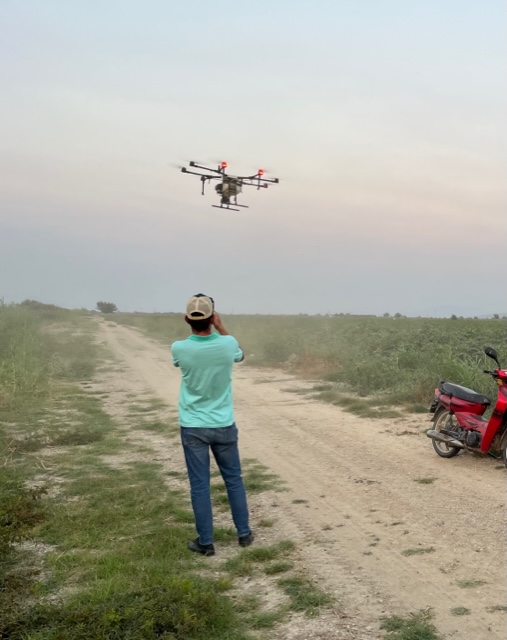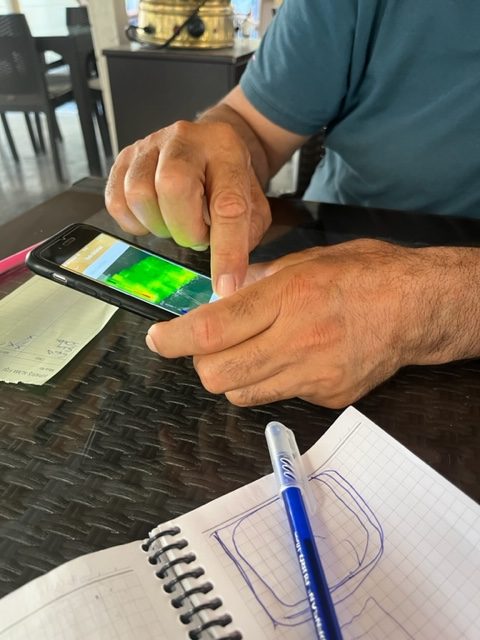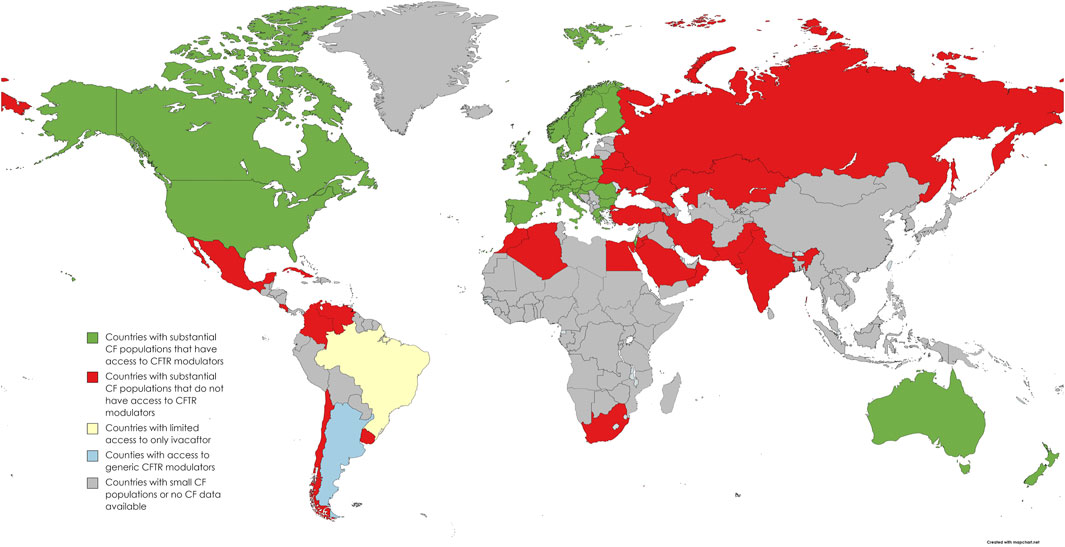Agricultural digitization not only sparks the imagination of humans being replaced by automation and data but also creates participatory models in corporate settings that aim to incorporate farmers’ know-how and practices into technology development. This participatory approach to technology...
In 2022, I was conducting my doctoral dissertation research on data-driven, automated digital farming technologies (drones, autosteering, sensors, GIS, smartphones, Big Data) in Turkey. Amidst the global hype for digital agriculture, often referred to as “smart” farming or precision agriculture, new agritech companies and startups in and beyond Turkey have been emerging alongside agribusiness corporations. These companies invest in and prioritize data-driven and algorithmic technologies over human involvement in agriculture with the assumption of the former’s objectivity and precision (Bronson 2022). For instance, the market in Turkey provides farmers with access to drones for precise chemical spraying, including fertilizers and pesticides. These drones operate autonomously, enabling farmers to target specific sub-fields rather than resorting to mass spraying. Farmers can also access various smartphone applications that, for instance, claim to offer real-time data on soil conditions at the sub-field level collected through sensors and algorithmic recommendations ensuring precise irrigation. Additionally, the companies imagine generating valuable insights into the agricultural sector for agricultural corporations, financial and biotechnology firms, and public institutions through these data-driven technologies. While not all of these technologies are extensively used by farmers in Turkey, the companies continue developing, marketing, and showcasing them and many others to automate and gather data for a wide range of agricultural operations with the claim of improving food security and ecological and socioeconomic welfare.

A farmer observing a drone performing pesticide spraying over a cotton farm. (Image by Author)
Although my research primarily focused on agriculture in Turkey, it frequently required me to explore connections beyond the country. For instance, one day, I received a notification from LinkedIn about a new post by Andrew Bate, the founder of Swarm Farm Robotics and Director of Bendee Farming in Australia. His biweekly newsletter, titled “My dad used to drive a tractor,” not only hints at the hype for the ongoing transition from mechanization to information technologies in agriculture but also delves into the challenges and concerns surrounding digital farming. In the new post, Bate (2022) argues that the market offers cutting-edge advancements in autonomous technologies for the sake of innovation and competition that mostly serve large-scale farming and thus these technologies do not “put the farmer’s needs first.” He argues that “farming is inherently local, requiring that we build in flexibility at scale” and introduces their “integrated autonomy” approach to autonomous technologies that “beg[ins] with the farmer” and their “local” needs and conditions through customizable software that they develop collaboratively (Bate 2022).
Bate’s concerns about digital farming speak to a longstanding discussion in studies of agricultural development (Chambers et al. 1989), and one that I have encountered during my research in Turkey. Participatory development models have long emphasized the importance of involving communities and various stakeholders in techno-scientific development processes. Similarly, Bate’s newsletter shows that the hype for digital farming also generates critical reflections on technocratic, off-farm tendencies within corporate settings. In this post, I focus on how these concerns, as well as the efforts to address them, have given rise to new imaginations regarding algorithmic calculations in agriculture, particularly the digitalization and automation of farm work. My exploration draws from multi-sited research conducted for my doctoral dissertation, which has taken me to digital farming technology companies, including a smart village project, in Turkey and beyond through the networks of technology.
Digital technologies in general, spanning from blockchain systems to smartwatches and ChatGPT, raise a host of concerns related to privacy, data ownership, equitable access to technology, discrimination and racism, environmental degradation, diminishing labor demands, and various others. Companies in the digital agriculture sector have also initiated discussions on challenges posed by digital farming technologies. Like Bate, some question whether the newly emerging digital farming technologies effectively address the needs, interests, and socioeconomic and ecological conditions of farmers. Moreover, there is a well-known fact that a gap between farmers and technology hinders essential data collection at field and subfield levels (Friedberg 2020). To bridge the gap, professionals in digital farming technology companies in Turkey, such as product managers, software developers, marketing managers, and UX/UI designers, regularly update their technologies. They utilize the customizable features of digital infrastructures and integrate user (farmers) feedback gathered through customer data via tools like Google Analytics or Hotjar, as well as through in-person interactions or Zoom meetings with farmers.
Such participatory models are evolving with the increasing digitalization of everyday life (Kelty 2019). This is frequently discussed in the context of social media platforms, where free user inputs (such as “likes” on Facebook) are crucial for companies’ profitability, as they play a significant role in shaping algorithmic calculations and aggregating information on these platforms. For instance, Fourcane and Kluttz (2020) interpret this participatory data generation on digital platforms as “accumulation by gift” (a la Mauss). They emphasize that users’ access to digital platforms appears to be free, but it is indeed in return for data generated through their use. This dynamic creates a “gift-like” relationship or “bargain” that “not only masks the structural asymmetry between giver and gifted but also permits the creation of the new commodity of personal data, obfuscates its true value, and naturalizes its private appropriation.”
Digital farming technology companies in Turkey also engage in practices that can be characterized as “accumulation by gifts.” One company develops smartphone applications for farming within the framework of participatory development. They design these apps to provide farmers, for instance, with access to satellite images of their own farms for assessing vegetation conditions and taking appropriate actions. However, they simultaneously appropriate data as farmers use the apps, which could be utilized for the further development and marketing of these applications and related technologies (see also Miles 2019).

A farmer using a smartphone application to view satellite images of his farm. (Image by Author).
Furthermore, my fieldwork in a “smart village” project in western Turkey has provided me with the opportunity to observe that such participatory attempts by companies lead to additional concerns and imaginations regarding automation and farmers’ labor on farms. The smart village project is owned by a “social entrepreneur” company. They develop, test, and showcase various digital farming technologies on their pilot farms with the objective of integrating the insights they glean from farmers on farms into their technology development.
One day, the research and development director of the smart village asked me to attend virtually and write a report on the annual hybrid (online and in-person) event of the AgROBOfood project. This event, supported by the European Union under Horizon 2020, took place at Wageningen University in the Netherlands between April 6-8, 2022. In AgROBOfood, various entities from different digital innovation hubs across Europe, such as the smart village, come together to build networks while developing robotic innovations for agriculture. On the second day of the event, a start-up company founder from Denmark introduced their field robot. He underlined that the automated features of their robot would contribute to food security and “the green transition of future food production” by addressing labor-intensive tasks, including seeding, weeding, and spraying, amid increasing weed resistance, pesticide use, and soil degradation in agriculture. Additionally, the robot provides farmers with data-driven feedback on farm conditions via real-time sensors, aiding in agricultural decision-making and cost-effectiveness. During his presentation over Zoom, before introducing the details of the robot, he displayed an image of a horse pulling an old-fashioned manual plow, guided by an elderly farmer dressed in blue jeans, a jacket, and a cap. The founder claimed that their engineering team drew insights from these older farming practices while developing their robot’s features. He was underlying the connections between analog human- and animal-centered farming practices and automated technologies that they develop. It was interesting to note this start-up company founder from Denmark emphasizing a participatory approach to digital farming, a pattern I have witnessed repeatedly in the Turkish smart village, as well as in Bate’s above-mentioned post.
However, this participatory image of the robot’s development processes was not enough to steer away some concerns of the participants. During the Q&A session, one of the audience members claimed that these robots automating and datafying farm work could disconnect farmers from each other, particularly the younger generation from the older generation. This could potentially hinder the transfer of ecological know-how from the older generation to younger farmers. In response, the founder of the company began by emphasizing his personal background, stating that he was born and raised on a family farm. He claimed that we had already lost these intergenerational connections with our “grandfathers” due to large-scale farming practices and their overwhelming requirements. However, for him, robots could handle the “boring,” repetitive, and time-consuming tasks on large-scale farms. This would free up farmers’ time and resources to refocus on “agroecological optimization,” akin to the caring practices with the health of plants and soil that our “grandfathers” had undertaken and where “value” can be created.
Anthropologists have already underlined concerns about the potential dissolution of sociality among farmers, which is a significant component of farming and farmers’ autonomy, due to automation (Stone 2022). Against these concerns, the founder still emphasized the importance of participatory objectives in agriculture where farmers would not be displaced due to automation. In his imagination, robotic technologies would liberate farmers from labor-intensive, repetitive, and “boring” farm work, allowing them to redirect their resources towards agroecological tasks, e.g. caring for soil and plants. He regarded agroecological farm work as valuable compared to the “boring” farm work, seemingly devaluing the latter through automation. He distinguished the repetitive and labor-intensive farm work and agroecological tasks, as if the former had no positive or negative impacts on agricultural ecology. Caring for soil and plants becomes farmers’ future assignments, and once everyday repetitive tasks are addressed in the present without humans’ involvement. While these repetitive tasks might also be indeed “essential to ecological relations of care,” he seems to consider them as “wasted time” in the productionist temporality, as Puig de la Bellacasa (2016, 708) asserts.
In conclusion, agricultural digitization not only sparks the imagination of humans being replaced by automation and data, but also creates participatory models in corporate settings that aim to incorporate farmers’ know-how and practices into technology development. This participatory approach to technology development contributes to capital accumulation in new ways in parallel with the digitalization of everyday life. Moreover, it leads to the emergence of novel imaginations about automated farm work while also redefining the value and the division of labor on farms. Here, the hype for automation is going hand in hand with the devaluation of the automated tasks. While Ekbia and Nardi (2017, 1) point to “heteromation,” not automation, to underline how “economic value” is still extracted “from low-cost or free labor in computer-mediated networks,” the emerging valuation as well as devaluation of automated repetitive farm work and their implications on farmers’ ecology and socioeconomic life need critical ethnographic reflections.
Acknowledgements
I would like to express my gratitude to the participants in this project, which also received support from a Wenner-Gren Dissertation Fieldwork Grant, a Social Science Research Council International Dissertation Research Fellowship (SSRC-IDRF), a National Science Foundation Doctoral Dissertation Research Improvement Grant (NSF-DDRIG) (Award No: BCS-2115365), an American Philosophical Society Lewis and Clark Fund for Exploration and Field Research, and grants from the School of Anthropology, University of Arizona. I also extend my thanks to Brian Silverstein, Mine Egbatan, Damla Çakmak, and the Platypus team for reviewing earlier drafts of this article.
References
Bate, Andrew. 2022. “When You’re a Hammer, Everything Looks Like A Nail: A Collaborative Approach to Autonomy.” LinkedIn. https://www.linkedin.com/pulse/when-youre-hammer-everything-looks-like-nail-approach-andrew-bate?trk=portfolio_article-card_title
Bronson, Kelly. 2022. The Immaculate Conception of Data: Agribusiness, Activists, and Their Shared Politics of the Future. McGill-Queen’s University Press.
Chambers, Robert, Arnold Pacey, and Lori Ann Thrupp. 1989. Farmer First: Farmer Innovation and Agricultural Research. Intermediate Technology Publications.
Ekbia, Hamid R., and Bonnie A. Nardi. 2017. Heteromation, and Other Stories of Computing and Capitalism. Cambridge, Mass.: MIT Press.
Fourcade, Marion, and Daniel N. Kluttz. 2020. “A Maussian Bargain: Accumulation by Gift in the Digital Economy.” Big Data & Society, 7(1).
Freidberg, Susanne. 2020. “‘Unable to Determine’: Limits to Metrical Governance in Agricultural Supply Chains.” Science, Technology, & Human Values, 45(4): 738–760.
Kelty, Christopher M. 2019. The Participant: A Century of Participation in Four Stories. The University of Chicago Press.
Miles, Christopher. 2019. “The Combine will Tell the Truth: On Precision Agriculture and Algorithmic Rationality.” Big Data & Society, 6(1).
Puig de la Bellacasa, Maria. (2015). “Making Time for Soil: Technoscientific Futurity and the Pace of Care.” Social Studies of Science, 45(5), 691–716.
Stone, Glenn Davis. 2022. “Surveillance Agriculture and Peasant Autonomy.” Journal of Agrarian Change, 22(3), 608–631.















